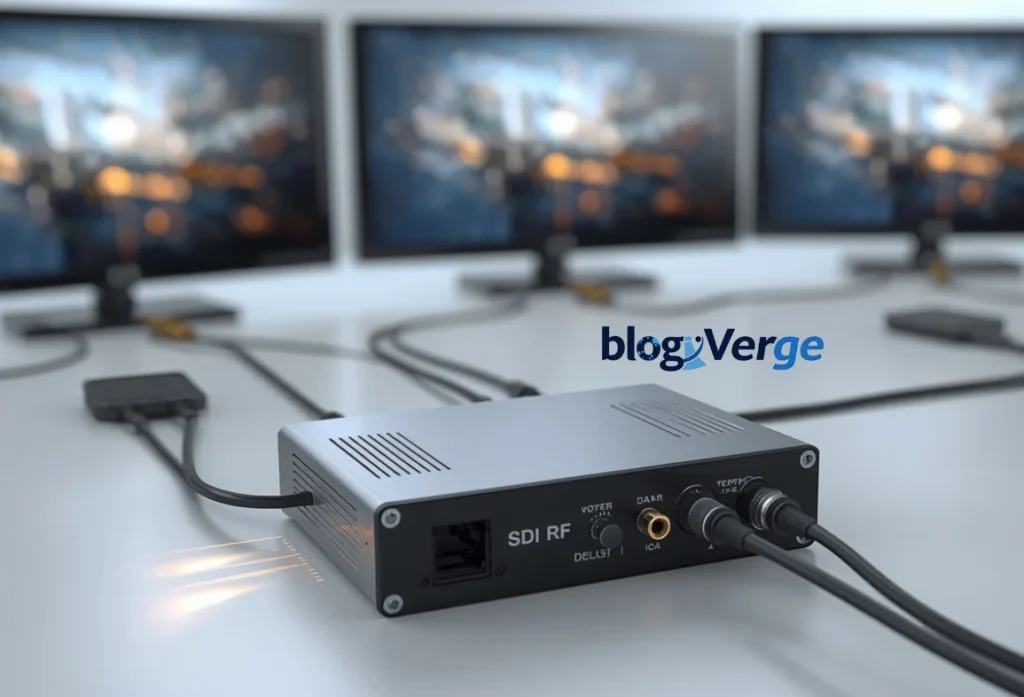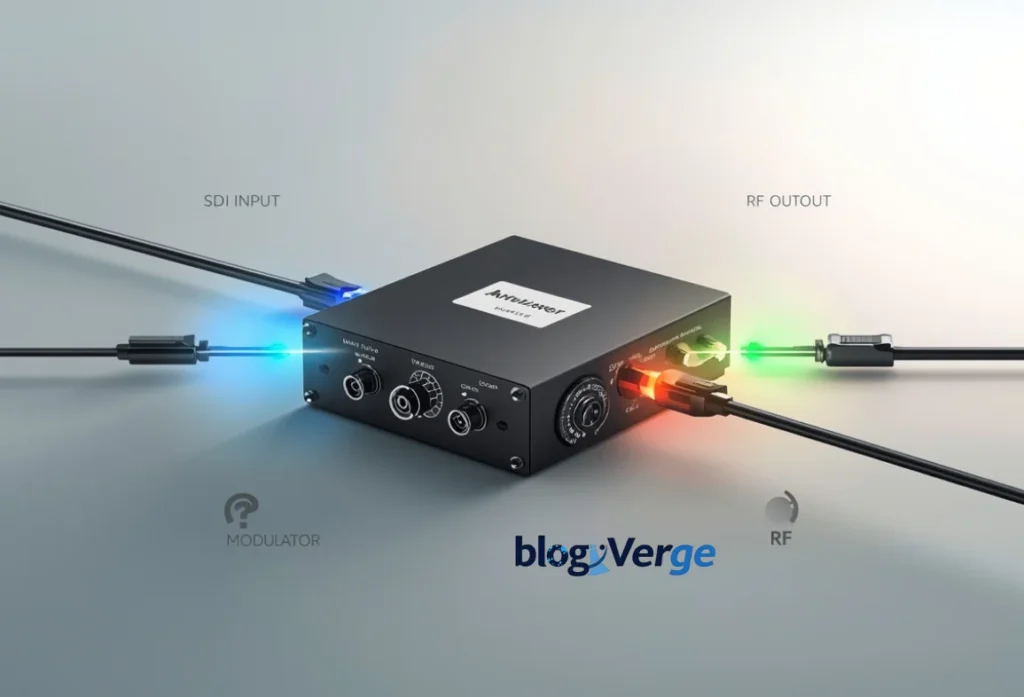There is nothing in the world of professional broadcasting that is not understood, and consistent signal distribution is essential. Reliability is imperative whether it is a live TV station, sports venue feed or hotel distribution. This is where the SDI RF modulator comes in. It is a solution that fills that gap between digital and analogue transmissions, hence preserving the quality of your video transmissions and providing a means of transferring them efficiently through the expansive infrastructure. The SDI RF modulator has become a crucial component in the modern AV and broadcasting landscape. It converts an SDI (Serial Digital Interface) into an RF (Radio Frequency) signal, and can be transmitted over coaxial cables.
It is thus appropriate where you are required to broadcast high-definition video television signals to various televisions or destinations without the expense of running an expensive digital network infrastructure. In this case, we will take a walkabout of everything you should know about the SDI RF modulators, including how they work, their primary advantages, the installation process, and their most common applications. Practical skills: You will also acquire practical skills, including choosing the most appropriate model, understanding important specifications, and maximising signal utilisation. The guide will help both beginners and experienced broadcast engineers decide whether to incorporate the use of SDI RF modulators into their workflow.
Table of Contents
What is an SDI RF Modulator?
The SDI RF modulator, which converts SDI video signals to RF, enables video to be conveyed through conventional coaxial cable networks. Serial Digital Interface (SDI) is a professional video standard commonly used for transmitting uncompressed digital video signals. This SDI signal is convertible into RF, and it is by this conversion that it can be utilised together with television tuners and any other RF-based systems. The conversion enables massive video delivery, i.e., delivering one HD or 4K signal to a large number of televisions in a stadium, hospital, hotel, or production plant without requiring any complex wiring.
Here is a simple breakdown:
- Input: SDI source that comprises video, audio and metadata.
- Output: RF signal (could be used with the standard TV tuners)
- Purpose: Lengthen the video range of distribution and retain signal quality.

Principle of an SDI RF Modulator
To understand how an SDI RF modulator works, consider it a translator between two systems: digital video (SDI) and analogue RF transmission. The modulator receives the SDI signal, encodes it, and then compresses it before modulating it into an RF carrier frequency that a television can receive.
Step-by-step process:
- Signal Input: An HD-SDI or a 3G-SDI video feed is connected to the modulator.
- Encoding: The video signal can be coded by MPEG-2 or H.264 compression.
- RF Conversion: The coded signal is passed through RF carrier frequency modulation.
- Output Distribution: Coaxial cables are used to distribute the signal to the TVs or receivers.
This enables one SDI file, such as a camera, video mixer, or computer output, to be distributed to more than one display without the need for intensive, costly digital infrastructure.

The significant advantages of an SDI RF Modulator
There are several advantages to using an SDI RF modulator, particularly for professional broadcasters and large-scale facilities.
1. Effective Signal Distributing
The SDI RF modulator allows you to transmit one video signal to multiple TVs over a single coaxial network, eliminating the need for separate receivers or HDMI splitters.
2. Long-Distance Transmission
RF signals have a significantly higher range of operation compared to HDMI or IP-based systems, with no apparent quality degradation, particularly when using RG6 or RG11 cables.
3. Cost-Effective Infrastructure
Existing coaxial cabling can be used, eliminating the need to purchase expensive IP-based rewiring.
4. High-Quality Video, Professional
SDI RF modulators of high-end capability can carry HD and even 4K signals with accuracy in colour and frame rate.
5. Scalability
It is easy to add new TVs or displays- they can be connected to the same RF network.
SDI RF Modulators Find Uses
SDI RF modulators have found applications in various areas where high-quality video distribution is required with high reliability.
1. Broadcast Studios
Assign SDI camera feeds or production output to control rooms and monitors to view and control.
2. Hotels and Hospitality
Deliver a video or TV channels to the guest rooms via the existing coaxial cable.
3. Sports Arenas and Stadiums
Stream live event content to the big screens and concessions simultaneously.
4. Educational Institutions
Live video and lecture shares across classes and auditoriums to increase the learning processes.
5. Hospitals
Entertains or provides informational channels in an efficient way to patient rooms, on time.
Installation of SDI RF Modulator
The installation of an SDI RF modulator is straightforward after knowing the fundamentals of the connections and setups.
Connect Your Source
Connect your SDI video source (i.e. a camera, encoder or production switcher) to the SDI input of the modulator.
Choose Output Channel
Adjust the RF channel of the output based on the control interface (or on-screen display) of the modulator.
Connect the RF Output
Install a coaxial cable between the RF output port and your distribution network for a TV.
Tune Receivers
Scan the new RF channel to receive the transmitted signal on the receiving TVs or tuners.
Fine-Tune Quality
Adjust the bitrate, modulation type (QAM, DVB-T, ATSC), and frequency so as to have the best picture quality.
Maintaining and Troubleshooting Ladies-tips
The maintenance and troubleshooting are easily done, and therefore, you are able to maintain your SDI RF modulator in a good state.
Check cables. Check that coaxial cables and SDI cables are loose.
Control Temperature: It must be ventilated; it is no good to overheat.
Firmware Updates: Ensure that the firmware of the modulator is updated in order to provide a better fit.
Check Check signal testing, Spectrum Check, Power output with spectrum analyser.
Backup Settings: It is advisable that you save your settings before modifying them.
Maintenance Walkthrough:
Conclusion
Even today, it is true that the SDI RF modulator is one of the most successful ways to distribute high-quality video signals in extensive coaxial networks. It offers a transitioning interface between professional video in SDI and consumer-level video in RF, both in live broadcasting and in hotel entertainment.
A decent SDI RF modulator will be worth the money as far as investment is concerned, in case you require a cheap, scalable, and reliable method of increasing your video distribution system. It is a simplifier of infrastructure that can provide broadcast-level performance in most industries.
FAQs
1. Can an SDI RF modulator that would support the 4K video?
Ans: Yeah, and those are the high-end models that are 4K and 6G-SDI/12G-SDI.
2. What type of cable do I need?
Ans: RG6/RG11 coaxial cables will be most appropriate for long distances.
3. Do I possess an amplifier which has an SDI RF modulator?
Ans: Yes, when you have a range of devices exceeding 100 meters and more, and you are doing distribution to more than a single point.
4. Does it support HDMI sources?
Ans: HDMI-to-SDI converters, or a hybrid of each, are added to some of the SDI RF modulators to allow these to be flexible.
5. Is it possible to use an SDI RF modulator on live broadcasting systems or CCTV systems?
Ans: Yes, SDI RF modulators are usually applied in live broadcast systems and CCTV systems to share high-quality video signals with the existing coaxial cable systems.

